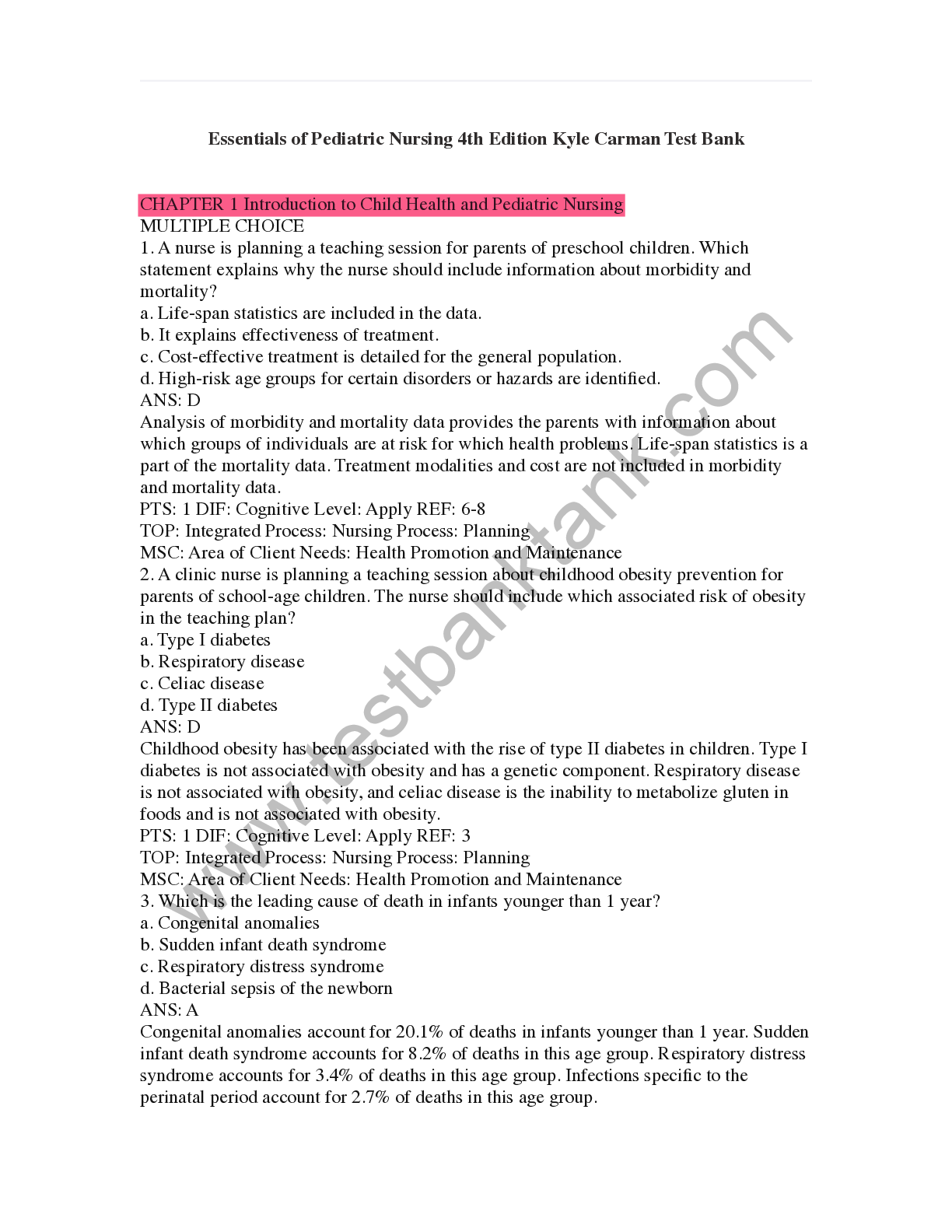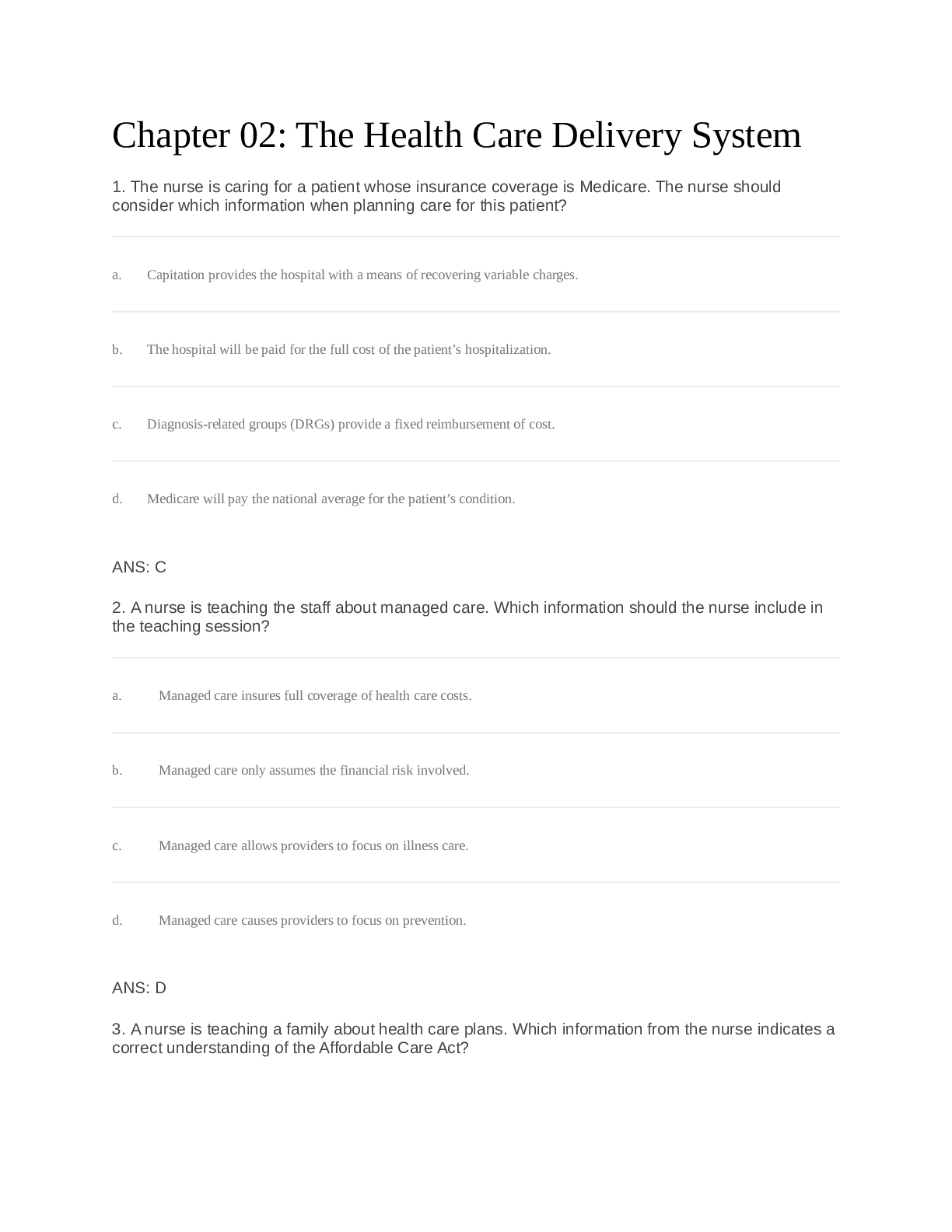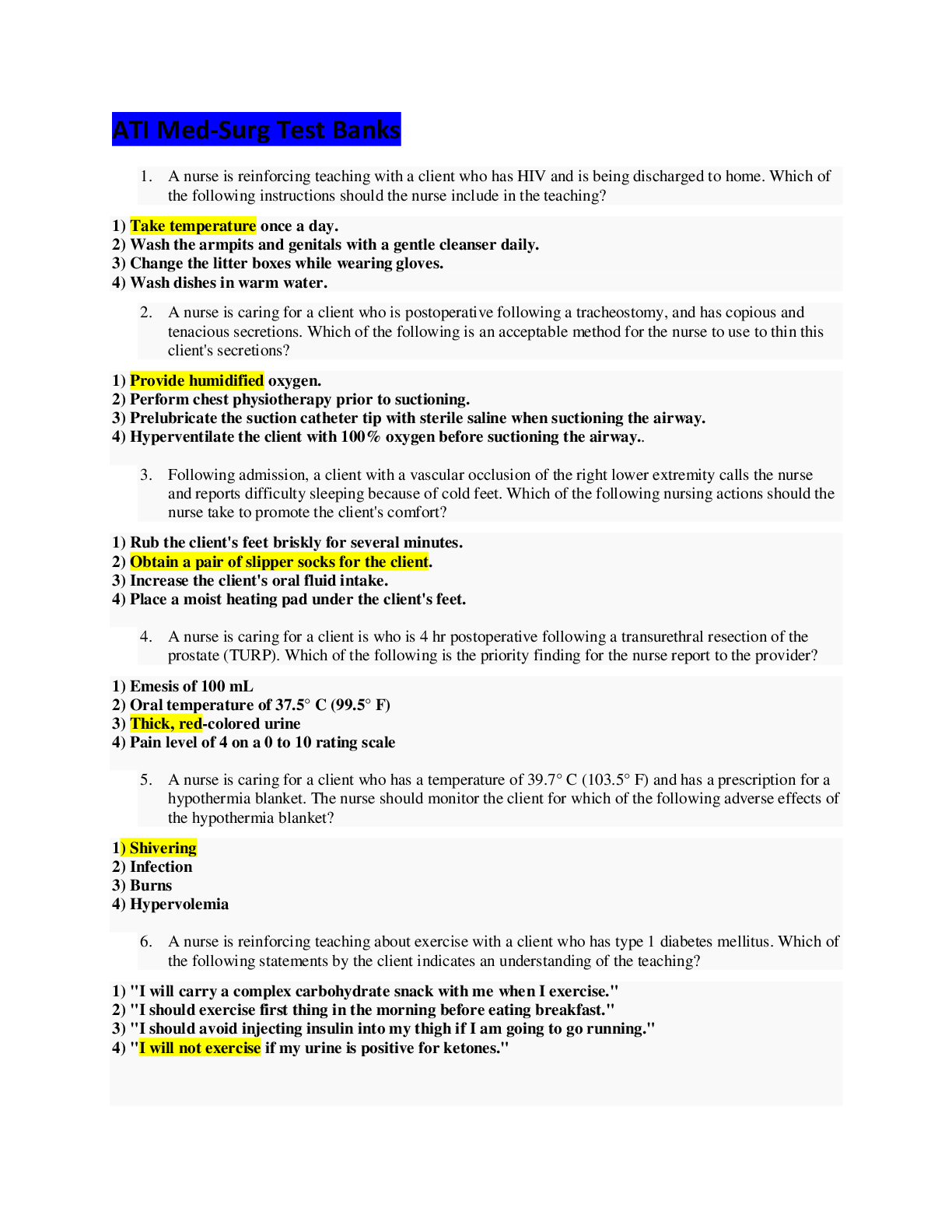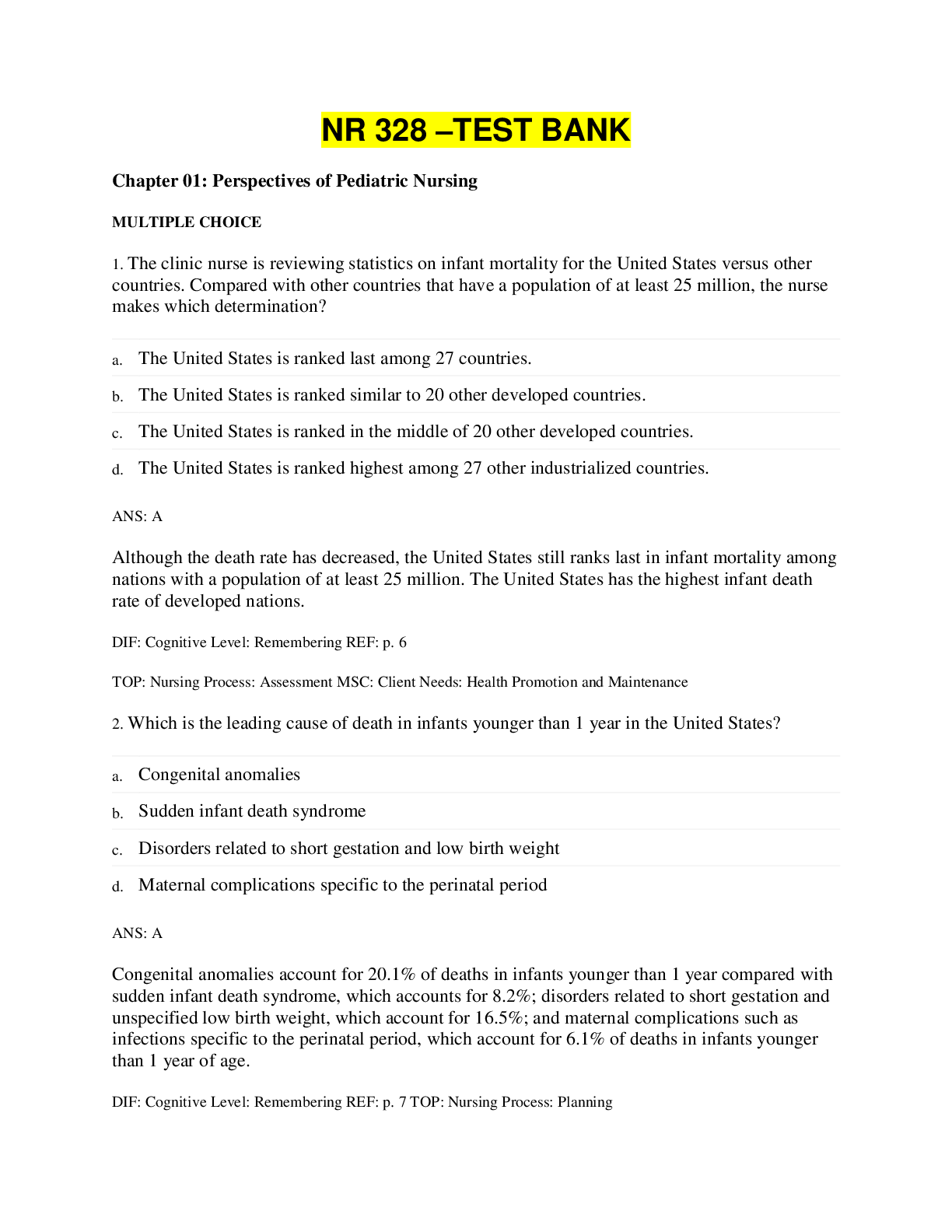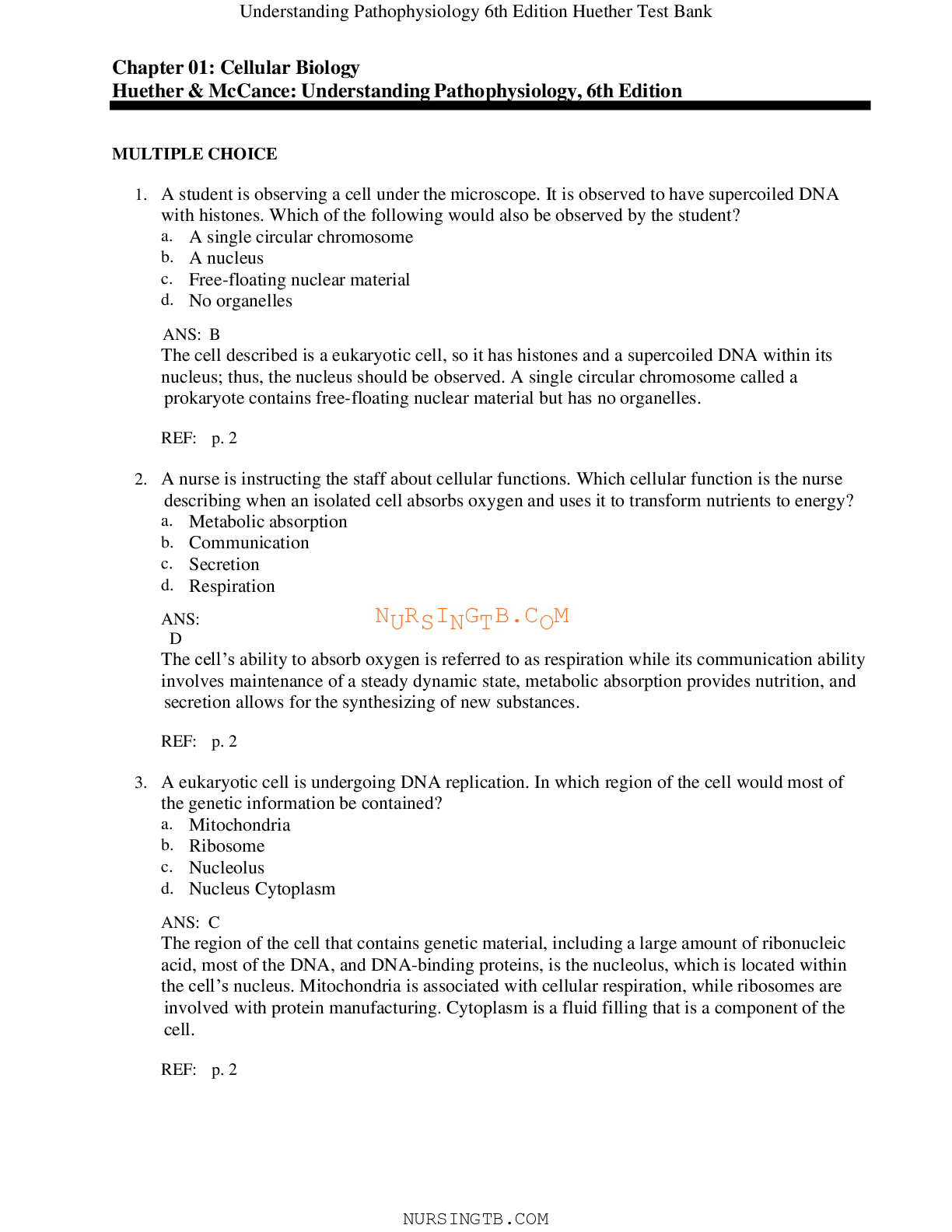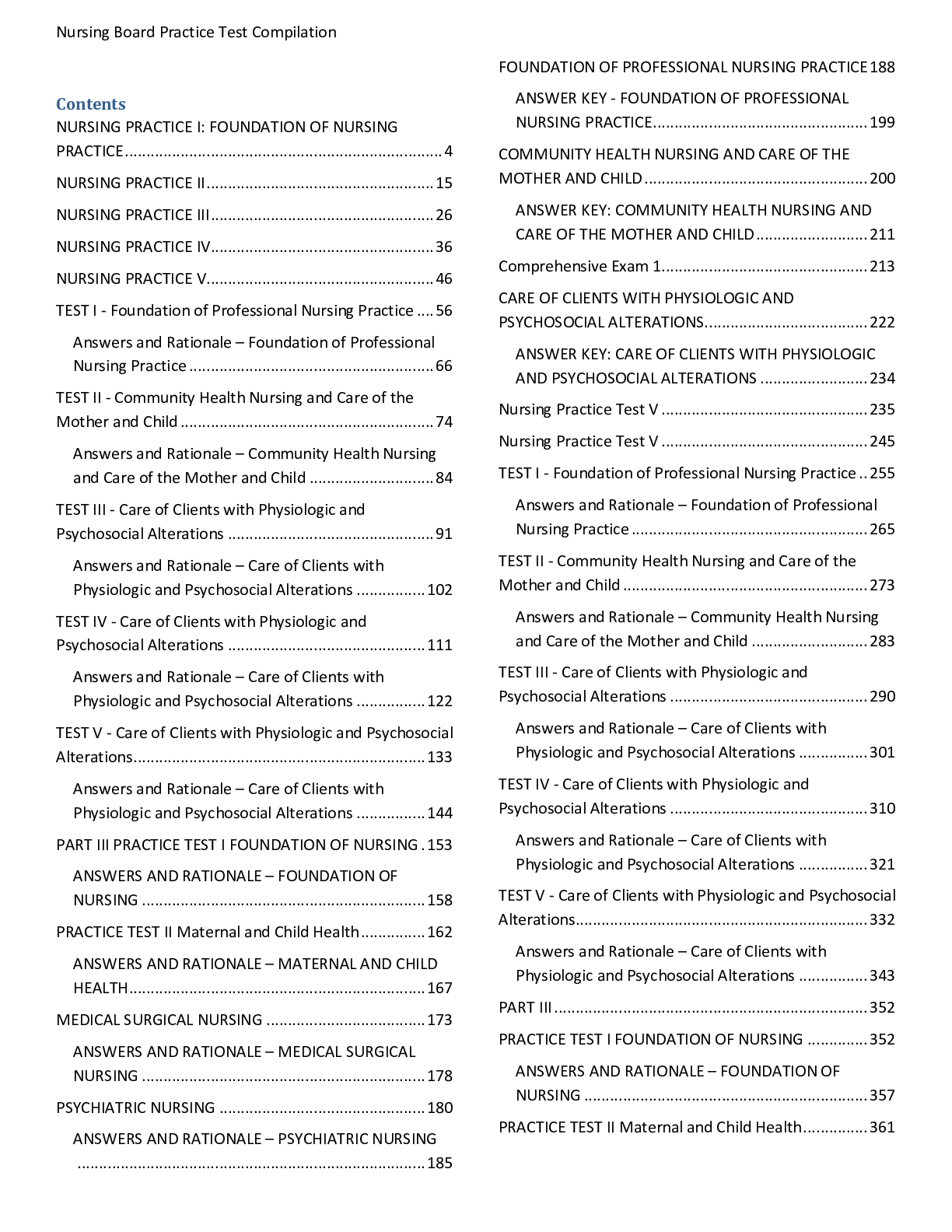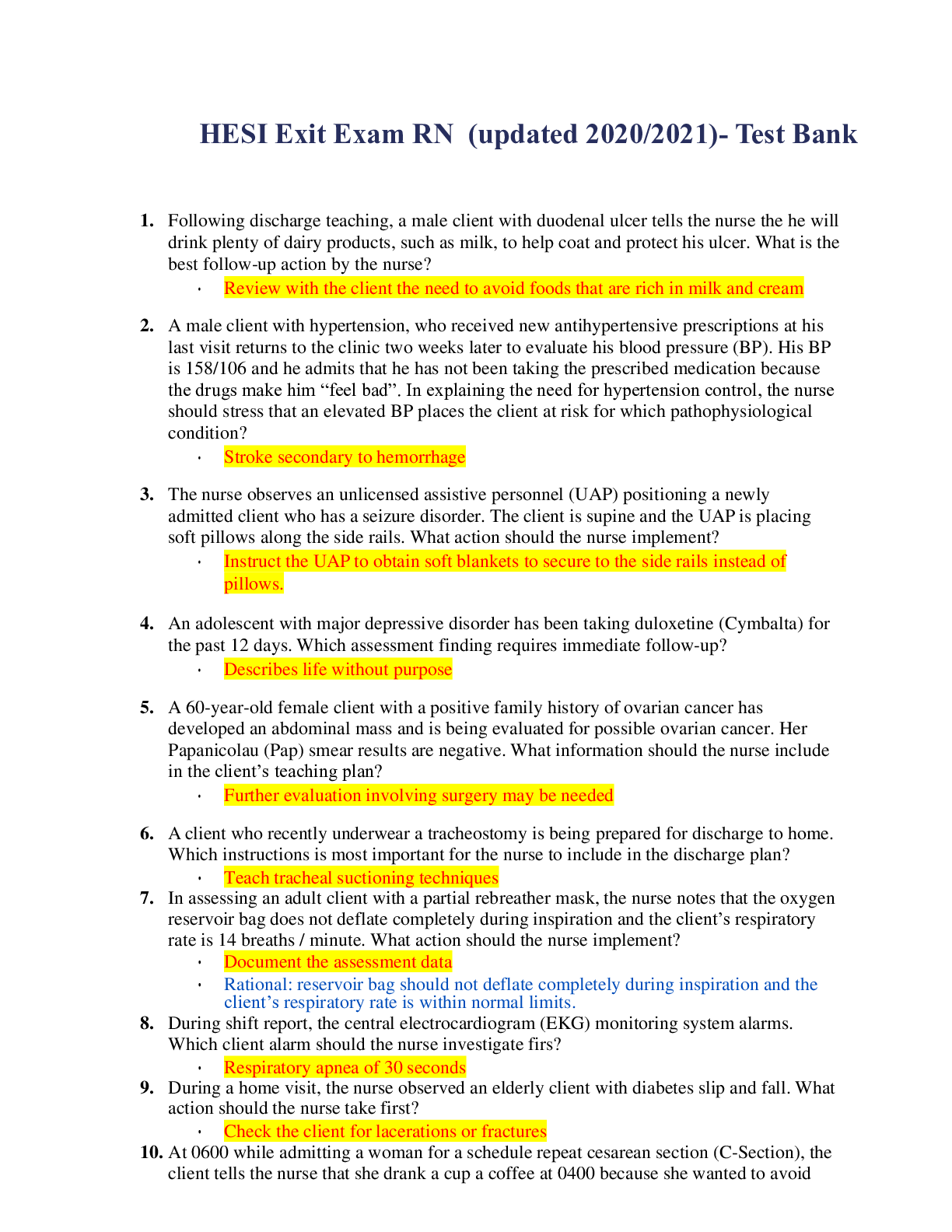*NURSING > TEST BANK > Fundamentals Nursing Active Learning 1st Edition Yoost Crawford - Test Bank (All)
Fundamentals Nursing Active Learning 1st Edition Yoost Crawford - Test Bank
Document Content and Description Below
Fundamentals Nursing Active Learning 1st Edition Yoost Crawford – Test Bank Chapter 03: Communication MULTIPLE CHOICE 1. The nurse is caring for an adult patient with a recent belo... w-the-knee amputation. During shift report, the nurse reports that the patient has urinated in the bed multiple times since the surgery. Which defense mechanism best describes this behavior? a. compensation b. denial c. rationalization d. regression ANS: D Regression is the return to an earlier developmental stage as a means of avoiding unpleasant or unacceptable thoughts. The adult patient recently lost a limb and reverted to bedwetting as a coping mechanism. Compensation refers to a strategy that uses a personal strength to counterbalance a weakness or a feeling of inadequacy. Refusing to accept a fact or reality as truth is termed denial. Rationalization is the act of suggesting a different explanation for one that is painful, negative, or unacceptable. DIF: Understanding REF: p. 51 OBJ: 3.8 TOP: Assessment MSC: NCLEX Client Needs Category: Psychosocial Integrity NOT: Concepts: Coping 2. A female patient is admitted to the emergency department after being raped by a neighbor. The patient refuses to discuss the circumstances surrounding the event with the sexual assault nurse examiner. This patient is most likely using the defense mechanism of: a. suppression b. sublimation c. displacement d. rationalization ANS: A Suppression is the conscious decision to conceal unacceptable or painful thoughts. The patient refuses to talk about the rape possibly because of the emotional and physical pain associated with the act. Sublimation is the rechanneling of unacceptable impulses into socially acceptable activities. Displacement is an unconscious defense mechanism used to avoid conflict and anxiety by transferring emotions from one object to another object that produces less anxiety. Rationalization is the act of suggesting a different explanation for one that is painful, negative, or unacceptable. DIF: Understanding REF: p. 51 OBJ: 3.8 TOP: Assessment MSC: NCLEX Client Needs Category: Psychosocial Integrity NOT: Concepts: Coping 3. A patient calls the nurse to report the smell of cigarette smoke in the bathroom. The event which triggers this communication process is referred to as the: a. channel. b. referent. c. message. d. feedback. ANS: B The elements of the communication process include a referent (i.e., event or thought initiating the communication), a sender (i.e., person who initiates and encodes the communication), a receiver (i.e., person who receives and decodes, or interprets, the communication), the message (i.e., information that is communicated), the channel (i.e., method of communication), and feedback (i.e. response of the receiver). DIF: Understanding REF: pp. 38-39 OBJ: 3.1 TOP: Assessment MSC: NCLEX Client Needs Category: Psychosocial Integrity NOT: Concepts: Communication 4. The nurse manager sends an e-mail to the nursing staff as a reminder for a scheduled monthly meeting. In doing so, the nurse manager understands that e-mail: a. is usually slower than other methods to disseminate knowledge. b. has the potential for miscommunication. c. cannot be used to deliver vital information. d. is especially effective because of the use of nonverbal cues. ANS: B A message is the content transmitted during communication. Messages are transmitted through all forms of communication, including spoken, written, and nonverbal modalities. Electronic communication in the form of information referencing, e-mail, social networking, and blogging can quickly contribute to a person’s knowledge, providing patients and health care professionals with vital information. However, the potential for miscommunication exists, in part because nonverbal cues are not apparent. DIF: Understanding REF: p. 39 | p. 42 OBJ: 3.1 TOP: Assessment MSC: NCLEX Client Needs Category: Psychosocial Integrity NOT: Concepts: Communication 5. The nursing student has been assigned to help feed patients at lunch time. Which of these nursing interventions would be most effective when assisting a blind patient to eat a meal? a. Speak loudly to ensure that the patient understands. b. Describe the food arrangement using the numbers on a clock. c. Tell the patient what is on the plate, assuming he has lost the sense of smell. d. Encourage the patient to eat faster so that the task will be done. ANS: B An important factor to remember when caring for visually impaired or blind patients is that they are rarely hearing impaired. Typically, blind patients have heightened auditory and olfactory senses. Communication with blind patients can be characterized as anticipatory in nature, meaning that the nurse should alert visually impaired patients of potential hazards or object locations to provide necessary information and safe care. For example, the nurse may inform the visually impaired patient that the meat entrée is in the 6 o’clock position and the coffee cup is at 2 o’clock on the tray. This system may be helpful in orienting blind patients to their hospital rooms. For example, from the vantage point of lying in bed, the bathroom may be at the 10 o’clock position and the phone at 5 o’clock on the bedside cabinet. Communication with sensory-impaired patients requires patience, creativity, and adaptation to ensure that patient needs are met. DIF: Applying REF: p. 49 | p. 52 OBJ: 3.9 TOP: Implementation MSC: NCLEX Client Needs Category: Psychosocial Integrity NOT: Concepts: Caregiving 6. The nurse observes a confused patient pacing back and forth in the dining room. The patient yells, “The doctor is going to make us all drink poison!” The most appropriate intervention at this time would be to: a. ask the patient why he would say something like that. b. change the subject to disrupt the patient’s thought process. c. tell the patient that he should probably think of something else. d. quietly ask the patient to explain the statement. ANS: D Seeking clarification encourages the patient to expand on a topic that may be confusing or that seems contradictory. Asking “why” questions implies criticism, may make the patient defensive, tends to limit conversation, requires justification of actions, and focuses on a problem rather than a possible solution. Changing the subject avoids exploration of the topic raised by the patient, and demonstrates the nurse’s discomfort with the topic introduced by the patient. Giving advice implies a lack of confidence in the patient to make a healthy decision DIF: Applying REF: pp. 47-48 | pp. 50-51 OBJ: 3.9 TOP: Implementation MSC: NCLEX Client Needs Category: Psychosocial Integrity NOT: Concepts: Caregiving 7. A patient with an inoperable brain tumor says to the nurse, “I just want to die now. It’s going to happen soon anyway.” Which of the following would be the most appropriate response? a. “Don’t worry about that right now. It’ll be OK.” b. “I disagree with what you just said!” c. “Honey, now don’t you talk like that.” d. “Tell me why you are saying that.” ANS: D Using open-ended questions or comments gives the patient the opportunity to share freely on a subject, avoids interjection of feelings or assumptions by the nurse, and provides for patient elaboration on important topics when the nurse wants to collect a breadth of information. Giving false reassurance discounts the patient’s feelings, cuts off conversation about legitimate concerns of the patient, and demonstrates a need by the nurse to “fix” something that the patient just wants to discuss. Showing agreement or disagreement discontinues patient reflection on an introduced topic, and implies a lack of value for the thoughts, feelings, or concerns of patients. Using personal terms of endearment, such as “Honey,” demonstrates disrespect for the individual, diminishes the dignity of a unique patient, and may indicate that the nurse did not take the time or care enough to learn or remember the patient’s name DIF: Applying REF: pp. 47-48 | pp. 50-51 OBJ: 3.7 TOP: Implementation MSC: NCLEX Client Needs Category: Psychosocial Integrity NOT: Concepts: Communication 8. The nurse is caring for a patient with chronic lung disease. The patient demands a cigarette after eating breakfast. The nurse responds, “If that was me, I wouldn’t be asking for a cigarette. That is what has made you so sick in the first place.” This nontherapeutic communication response is an example of: a. changing the subject. b. giving advice. c. a stereotypical response. d. defensiveness. ANS: B Giving advice implies that the patient cannot make his or her own decisions and the nurse accepts the responsibility for the action. Changing the subject ignores the patient’s concerns. Stereotypical or generalized responses such as, “Don’t cry over spilled milk” may be seen as judgmental. A defensive response such as, “The nurses work very hard to take care of you” moves the focus of the conversation from the patient and limits further discussion. DIF: Remembering REF: pp. 50-51 OBJ: 3.7 TOP: Assessment MSC: NCLEX Client Needs Category: Psychosocial Integrity NOT: Concepts: Communication 9. What would be an acceptable personal space distance for most English-speaking persons? a. 14 inches b. 18 inches c. 21 inches d. 24 inches ANS: B Proxemics refers to the amount of space or distance acceptable to two or more individuals based on cultural standards and personal preferences. Most English-speaking persons consider 18 inches to be an acceptable distance for communication. In general, intimate space is 0 to 1.5 feet; personal space is 1.5 to 4 feet; social space is 4 to 12 feet; and public space is 12 to 25 feet or more. DIF: Remembering REF: p. 40 OBJ: 3.2 TOP: Assessment MSC: NCLEX Client Needs Category: Psychosocial Integrity NOT: Concepts: Communication 10. Based on a patient’s perception of professional competence and caring, the nurse should wear: a. large, dangling, hoop earrings b. bright red, acrylic fingernails c. a clean, neatly pressed uniform d. offensive tattoos that cannot be covered ANS: C Professional symbolic expressions often communicate self-worth and pride. A clean uniform demonstrates a competent and caring demeanor. Patients consistently judge health care professionals by their appearance. The use of large amounts of jewelry, fake fingernails, and visible body markings, including body piercings, are generally not considered appropriate attire in the nursing profession. DIF: Applying REF: p. 41 OBJ: 3.2 TOP: Implementation MSC: NCLEX Client Needs Category: Psychosocial Integrity NOT: Concepts: Communication 11. The nurse is admitting a patient with a foul smelling leg wound. Which behavior by the nurse indicates an understanding of appropriate body language? a. Using hand gestures to enhance verbal communication b. Standing at the end of the bed with arms crossed c. Facial grimacing at the sight of the wound d. Gentle touching of the patient’s shoulder ANS: D Therapeutic touch, such as holding the patient’s hand or touching the patient’s shoulder, can provide comfort and may alleviate pain. This is especially true when a patient is undergoing a painful or stressful procedure. Making inappropriate facial expressions may be offensive and hurtful to patients or their family members. The nurse must control his or her facial expressions to avoid communicating disdain or judgmental attitudes in challenging patient care situations. Maintaining a neutral facial expression establishes an environment of caring and openness in which the patient and family members can feel safe to share their innermost concerns. The use of gestures may be challenging to nurses practicing in a multicultural environment. Although they may enhance verbal communication, gestures may be viewed as inappropriate by patients of various cultures. Standing with crossed arms may be indicating a lack of openness or acceptance. DIF: Applying REF: p. 40 | p. 43 OBJ: 3.2 TOP: Implementation MSC: NCLEX Client Needs Category: Psychosocial Integrity NOT: Concepts: Communication 12. Several nurses on a medical–surgical unit have been asked by the nurse manager to form a group and gather data regarding patient complaints of late meals. The nurses meet and establish ground rules. This phase of group development is called: a. forming. b. storming. c. norming. d. performing. ANS: A Tuckerman’s model of group performance includes forming, storming, norming, and performing. In the forming phase, there is little agreement on team goals other than those received from the leader, and there is a high dependence on the leader for guidance and direction. Ground rules are established and trust amongst the members begins to develop. There is unrest in the storming phase as the individual team members struggle for power and form cliques. Decisions do not come easily at this stage. In the norming phase the leader plays a facilitating and enabling role as the team begins to agree and engage in group decisions. Commitment and unity is strong. The team, in the performing phase, has a shared vision and works together to achieve the goals. DIF: Remembering REF: pp. 43-44 OBJ: 3.3 TOP: Assessment MSC: NCLEX Client Needs Category: Psychosocial Integrity NOT: Concepts: Communication 13. A nurse has been working with a patient for the entire shift. Which action by the nurse is unacceptable? a. Sharing a personal mobile phone number b. Touching the patient’s hand during a painful procedure c. Standing 6 feet away from the patient when conversing d. Using the SBAR method of hand-off communication ANS: A Professional role boundaries define the limits and responsibilities of nurses within a specific setting. It is unprofessional and unethical to share personal phone numbers or meet with patients outside of the health care setting. Therapeutic touch, such as holding the patient’s hand or touching the patient’s shoulder, can provide comfort and may alleviate pain. This is especially true when a patient is undergoing a painful or stressful procedure. Conversing 6 feet away is appropriate because it falls in the realm of social space; intimate space is 0 to 1.5 feet, personal space is 1.5 to 4 feet, and public space is 12 feet or more. One method of interpersonal communication that has been adopted to increase interprofessional and hand-off communication is the SBAR model (situation, background, action/assessment/awareness, and recommendation). DIF: Applying REF: p. 40 | p. 43 OBJ: 3.3 TOP: Implementation MSC: NCLEX Client Needs Category: Safe and Effective Care Environment: Management of Care NOT: Concepts: Ethics 14. During a shift report, a staff member briefly describes the history of a patient admitted with chronic gastrointestinal bleeding. In which SBAR topical area would this information be presented? a. Situation b. Background c. Assessment d. Recommendation ANS: B The “B” in SBAR stands for “Background,” or what led up to the current situation. The S stands for Situation or what is happening right now. The “A” stands for “Assessment,” or what is the identified problem, concern, or need. The “R” stands for “Recommendation,” or what actions or interventions should be initiated to alleviate the problem. DIF: Remembering REF: p. 43 OBJ: 3.3 TOP: Assessment MSC: NCLEX Client Needs Category: Safe and Effective Care Environment: Management of Care NOT: Concepts: Communication 15. The nurse is performing an abdominal assessment on a postoperative surgical patient. The nurse notes that the dressing needs to be changed twice a day and discusses when the patient would like to have it done. The nurse then plans to change the dressing at that time. In which phase of the nurse–patient helping relationship would this process occur? a. Introductory phase b. Orientation phase c. Working phase d. Termination phase ANS: C In the Working phase, there is the development of a contract or plan of care to achieve identified patient goals; implementation of the care plan or contract; collaborative work among the nurse, patient, and other health care providers, as needed; enhancement of trust and rapport between the nurse and the patient; reflection by the patient on emotional aspects of illness; and use of therapeutic communication by the nurse to keep interactions focused on the patient. In the Orientation phase or Introductory phase, introductions are made, establishing professional role boundaries (formally or informally) and expectations, and clarifying the role of the nurse. Identifying the needs and resources of the patient through observing, interviewing, and assessing the patient, followed by validation of perceptions. also occur in this phase. Termination involves alerting the patient to impending closure of the relationship, evaluating the outcomes achieved during the interaction, and concluding the relationship and transitioning patient care to another caregiver, as needed. DIF: Understanding REF: pp. 44-45 OBJ: 3.4 TOP: Evaluation MSC: NCLEX Client Needs Category: Physiological Integrity: Basic Care and Comfort NOT: Concepts: Caregiving 16. The nurse is collaborating with a patient to determine interventions to ensure compliance with medication administration after his pending discharge. The goals and nursing interventions would be agreed upon in the: a. Preinteraction phase. b. Orientation phase. c. Working phase. d. Termination phase. ANS: D Termination involves alerting the patient to impending closure of the relationship, evaluating the outcomes achieved during the interaction, and concluding the relationship and transitioning patient care to another caregiver, as needed. The Working phase involves the development of a contract or plan of care to achieve identified patient goals; implementation of the care plan or contract; collaborative work among the nurse, patient, and other health care providers, as needed; enhancement of trust and rapport between the nurse and the patient; reflection by the patient on emotional aspects of illness; and use of therapeutic communication by the nurse to keep interactions focused on the patient. In the Orientation phase or Introductory phase, introductions are made, establishing professional role boundaries (formally or informally) and expectations, and clarifying the role of the nurse. Identifying the needs and resources of the patient through observing, interviewing, and assessing the patient, followed by validation of perceptions. also occur in this phase. DIF: Understanding REF: pp. 44-45 OBJ: 3.4 TOP: Evaluation MSC: NCLEX Client Needs Category: Physiological Integrity: Basic Care and Comfort NOT: Concepts: Caregiving 17. A patient complains that several staff members entered the room during the morning bath without knocking. Which component of professional nursing communication has been violated in this scenario? a. Collaboration b. Advocacy c. Assertiveness d. Respect ANS: D Respect for the patient includes providing privacy during procedures such as a bath. It is considered respectful to knock on a patient’s door prior to entering the room. Assertive communication allows for the expressions of feelings and ideas without hurting or judging. Collaboration refers to the interactions with patients and health care workers to accomplish mutually acceptable goals. Advocacy involves defending the rights of others, especially those who are vulnerable or unable to make decisions independently. DIF: Understanding REF: pp. 45-46 OBJ: 3.6 TOP: Evaluation MSC: NCLEX Client Needs Category: Safe and Effective Care Environment: Management of Care NOT: Concepts: Caregiving 18. The nurse is caring for a patient who is unable to take oral medications because of persistent nausea and vomiting. The nurse decides to call the primary care physician and ask for a different medication administration route. This demonstrates the act of: a. collaboration. b. delegation. c. assertiveness. d. advocacy. ANS: D The nurse acts as a patient advocate by promoting what is best for the patient and ensuring that the patient’s needs are met. Since the patient is unable to take medications by mouth, it is the nurse’s responsibility to inform the physician and obtain alternative medication routes, as appropriate. Assertive communication allows for the expressions of feelings and ideas without hurting or judging. Collaboration refers to the interactions with patients and health care workers to accomplish mutually acceptable goals. Delegation is the art of transferring responsibility of an assigned task to another while at the same time retaining accountability for the outcome. DIF: Understanding REF: pp. 45-46 OBJ: 3.6 TOP: Evaluation MSC: NCLEX Client Needs Category: Safe and Effective Care Environment: Management of Care NOT: Concepts: Caregiving 19. The nurse is assisting a co-worker who is preparing to change a deep wound dressing on a patient’s abdomen. Several of the patient’s out-of-town friends are at the bedside watching a football game. Which action is most appropriate for the nurse to consider prior to the dressing change? a. Ask the friends to leave the room. b. Pull the curtain around the bed. c. Allow visitors to stay in the room during the procedure. d. Ask the patient to turn up the volume on the television. ANS: A It is appropriate for the nurse to ask visitors to leave a patient’s room for a few minutes. Several factors affect the location appropriate for communication with patients. Privacy and confidentiality are critical during the interviewing and assessment process. Simply pulling a cubicle curtain around a patient’s bed does not prevent the transmission of sound beyond the curtain. Make every effort to talk with patients in an environment with as few interruptions and distractions as possible. Ask the patient to turn off competing technology and to focus on the nurse–patient interaction as needed. DIF: Applying REF: p. 45 OBJ: 3.5 TOP: Implementation MSC: NCLEX Client Needs Category: Safe and Effective Care Environment: Management of Care NOT: Concepts: Caregiving 20. The nurse is conducting a presurgical screening interview with a patient at a local surgical center. When performing a health assessment, the primary source of information should be: a. the spouse. b. the medical record. c. a close relative. d. the patient. ANS: D The primary source from which data are collected is the patient. A secondary source would include a significant other, family members, caregivers, other members of the health team, and medical records. DIF: Remembering REF: p. 45 OBJ: 3.5 TOP: Assessment MSC: NCLEX Client Needs Category: Safe and Effective Care Environment: Management of Care NOT: Concepts: Caregiving 21. A mother of a young child kicks a trashcan in anger and says to the nurse, “You just don’t understand! Why can’t the doctor find out what is wrong with my child?” This behavior is most likely an example of: a. suppression b. sublimation c. displacement d. rationalization ANS: C Displacement is an unconscious defense mechanism used to avoid conflict and anxiety by transferring emotions from one object to another object that is less anxiety-producing. The mother is upset that the health care team is not able to determine the cause of her child’s illness and expresses her anger by kicking the trashcan. Suppression is the conscious decision to conceal unacceptable or painful thoughts. Sublimation is the rechanneling of unacceptable impulses into socially acceptable activities. Rationalization is the act of suggesting a different explanation for one that is painful, negative, or unacceptable. DIF: Understanding REF: p. 49 | p. 51 OBJ: 3.8 TOP: Assessment MSC: NCLEX Client Needs Category: Psychosocial Integrity NOT: Concepts: Coping 22. The nurse is caring for a patient scheduled for a partial mastectomy resulting from advanced cancer. The patient tells the nurse, “I’m sure when the surgeon operates on me, he will not find any cancer in my breast. It looks just fine.” The patient is using which defense mechanism to cope with the medical diagnosis? a. Suppression b. Sublimation c. Displacement d. Denial ANS: D The patient is refusing to admit that the breast has to be removed because of cancer. This inability to accept the truth is termed denial. Displacement is an unconscious defense mechanism use to avoid conflict and anxiety by transferring emotions from one object to another object that is less anxiety- producing. Suppression is the conscious decision to conceal unacceptable or painful thoughts. Sublimation is the rechanneling of unacceptable impulses into socially acceptable activities. DIF: Understanding REF: p. 49 | p. 51 OBJ: 3.8 TOP: Assessment MSC: NCLEX Client Needs Category: Psychosocial Integrity NOT: Concepts: Coping MULTIPLE RESPONSE 1. A helping relationship develops through ongoing, purposeful interaction between a nurse and a patient. Nurse–patient relationships focus on: (Select all that apply.) a. building trust. b. demonstrating empathy. c. tearing down boundaries. d. developing a plan of care. ANS: A, B, D A helping relationship develops through ongoing, purposeful interaction between a nurse and a patient. The focal point of the nurse–patient helping relationship is the patient and the patient’s needs and concerns. Nurse–patient relationships focus on five areas: (1) building trust, (2) demonstrating empathy, (3) establishing boundaries, (4) recognizing and respecting cultural influences, and (5) developing a comprehensive plan of care. DIF: Understanding REF: pp. 44-45 OBJ: 3.6 TOP: Assessment MSC: NCLEX Client Needs Category: Psychosocial Integrity NOT: Concepts: Communication 2. The nurse is administering a bath to a hearing-impaired patient. The nurse should: (Select all that apply.) a. speak very loudly into the patient’s right ear. b. control background noise as much as possible. c. turn away when responding to a question. d. adjust the lighting in the room. e. be wary of consistent affirmative answers. ANS: B, D, E When communicating with a hearing-impaired patient, the nurse should make sure that the area is well lit with as little background noise as possible. Hearing aids amplify all sounds, making noisy environments confusing and frustrating. Raising the voice level slightly, speaking clearly, and making sure that the patient can see the nurse’s face helps to facilitate communication. Adequate lighting enhances the patient’s ability to see the speaker’s mouth and face and interpret nonverbal communication. Consistent affirmative answers to the nurse’s questions may be an indication that the patient is not hearing the information being shared. Care should be taken to verify that patients truly understand the content of verbal interaction. Extra patience may be required by the nurse to demonstrate caring while communicating with hearing-impaired patients. DIF: Applying REF: p. 51 OBJ: 3.9 TOP: Implementation MSC: NCLEX Client Needs Category: Psychosocial Integrity NOT: Concepts: Communication 3. The nursing student is writing a report on the use of nonverbal techniques to encourage therapeutic communication. Which examples should be included in the report? (Select all that apply.) a. Providing a backrub b. Remaining silent c. Avoiding distracting body movements d. Facing the patient e. Nodding ANS: A, B, C, D Feedback: Providing a backrub is considered therapeutic touch; additional examples include holding a patient’s hand and gently touching a patient’s arm. Silence refers to being present with a patient without verbal communication. Facing the patient and avoiding unusual body movements are active listening techniques. Nodding is conveying acceptance and is considered verbal. DIF: Remembering REF: pp. 47-49 OBJ: 3.7 TOP: Assessment MSC: NCLEX Client Needs Category: Psychosocial Integrity NOT: Concepts: Communication Chapter 04: Critical Thinking in Nursing MULTIPLE CHOICE 1. The patient is complaining of severe incisional pain 2 days after surgery. The patient has Morphine ordered intravenously or by mouth. The nurse chooses to give the medication orally. This is an example of: a. decision making. b. reasoning. c. problem solving. d. judgment. ANS: A Decision making requires choosing a solution to a problem. Reasoning is the process by which a nurse determines a patient’s health status after gathering data and applying meaning to behaviors and physical signs and symptoms. A systematic approach in finding solutions is termed problem solving, and judgment is the process of forming an opinion by comparing solutions through reasoning. DIF: Remembering REF: p. 56 OBJ: 4.1 TOP: Assessment MSC: NCLEX Client Needs Category: Safe and Effective Care Environment: Safety and Infection Control NOT: Concepts: Clinical Judgment 2. The nurse is reviewing the last 3 days of a patient’s pain history and notes that the pain level has remained constant. The nurse validates the pain level with the patient and decides to contact the physician for further orders. In this scenario the nurse is using the process of: a. decision making. b. reasoning. c. problem solving. d. judgment. ANS: D Processes dependent on critical thinking include problem solving, decision making, reasoning, and judgment. Judgment is the process of forming an opinion by comparing solutions through reasoning. The nurse observes that the patient’s pain level is not decreasing and further assesses the pain level through discussions with the patient. The nurse concludes that the patient’s pain should be further addressed and contacts the physician. Decision making requires choosing a solution to a problem. The student is making a decision by reviewing two pertinent resources related to the removal of staples. Reasoning is the process by which a nurse determines a patient’s health status after gathering data and applying meaning to behaviors and physical signs and symptoms. A systematic approach in finding solutions is termed problem solving. DIF: Remembering REF: p. 56 OBJ: 4.1 TOP: Assessment MSC: NCLEX Client Needs Category: Safe and Effective Care Environment: Safety and Infection Control NOT: Concepts: Clinical Judgment 3. The nurse has been hired for her first job and is nervous about making errors in clinical judgment. It is important for the nurse to realize that clinical reasoning and the ability to make decisions in a clinical setting: a. has been instilled in the content covered in nursing school. b. is solely based in clinical experience. c. develops over time with increased knowledge and expertise. d. is an expectation of all nurses regardless of experience. ANS: C Clinical reasoning uses critical thinking, knowledge, and experience to develop solutions to problems and make decisions in a clinical setting. A nurse’s clinical-reasoning skills develop over time with increased knowledge and expertise. DIF: Understanding REF: p. 56 OBJ: 4.1 TOP: Assessment MSC: NCLEX Client Needs Category: Safe and Effective Care Environment: Safety and Infection Control NOT: Concepts: Clinical Judgment 4. The nurse is taking an advanced cardiac life support (ACLS) recertification class. As part of that class, the nurse, and other nurses in the group, rotates responsibilities during multiple mock code exercises simulating cardiac arrest scenarios. The process of assigning nurses to different responsibilities is known as: a. concept mapping. b. simulation. c. role playing. d. literature review. ANS: C A role-play strategy involves assigning learners to different roles based on expected outcomes in a particular setting. Other learners and facilitators observe the role playing, and then all are involved in the debriefing or discussion of the scenario. As with simulation, this approach allows learners to interact in a safe, controlled environment. The concept map is a way to organize and visualize data to identify relationships and solve problems. Simulated experiences enable the student to apply previously learned content in a safe and realistic environment that allows time for questioning, clarifying, and feedback. Students develop confidence in providing direct nursing care. Because critical thinking cannot occur about subjects that are unknown, a review of literature may foster this type of thinking by addressing knowledge deficits. DIF: Understanding REF: pp. 63-64 OBJ: 4.7 TOP: Assessment MSC: NCLEX Client Needs Category: Safe and Effective Care Environment: Management of Care NOT: Concepts: Care Coordination 5. The nurse is preparing to administer an anticoagulant when the patient says, “Why do I have these bruises on my arms?” The nurse reviews the patient’s blood tests and notes an abnormal bleeding time. Based on the findings, the nurse decides to hold the medication and notifies the health care provider. This action, by the nurse, is an example of: a. thinking aloud. b. reviewing the literature. c. applying knowledge . d. role playing. ANS: C Nursing practice is based on the application of knowledge to address patient problems. Nurses may “think aloud” as an inner dialogue to examine their thinking. The literature review is used to address knowledge gaps through the review of scholarly journals. A role-play strategy involves assigning learners to different roles based on expected outcomes in a particular setting. Other learners and facilitators observe the role playing, and then all are involved in the debriefing or discussion of the scenario. As with simulation, this approach allows learners to interact in a safe, controlled environment. DIF: Understanding REF: pp. 63-64 OBJ: 4.7 TOP: Assessment MSC: NCLEX Client Needs Category: Safe and Effective Care Environment: Management of Care NOT: Concepts: Care Coordination 6. The nurse is preparing to restart a patient’s intravenous line and discovers that the patient has no usable veins in either arm. To solve this problem, the nurse should: a. discuss the problem with the nurse in charge. b. not start the intravenous line. c. conduct an internet search for infusion journal articles. d. contact the physician and report the concern. ANS: A Whether in an academic setting or in the clinical area, discussion of a problem, issue, or situation with colleagues may improve critical thinking. Through dialogue with others who have expertise or experience with the issue being faced, knowledge gaps can be filled, erroneous assumptions exposed, and unconscious biases addressed. Not starting the intravenous line is not an option at this point. A literature review to gain published information about intravenous complications may be appropriate after the patient’s concern has been addressed. Initially contacting the physician without fully exploring the options for alternate insertion sites is neither wise nor recommended. DIF: Applying REF: p. 63 OBJ: 4.7 TOP: Implementation MSC: NCLEX Client Needs Category: Safe and Effective Care Environment: Management of Care NOT: Concepts: Care Coordination 7. The nurse has finished her shift and is on her way home. During the shift, one of the patients attempted to climb out of bed and fell. On her way home the nurse is thinking about what she could have done differently to prevent the fall. This is an example of using: a. evidence b. standards c. attributes or traits. d. reflection ANS: D Reflection is an effective tool that enables students and nurses to think about how best to improve their future caregiving in similar situations. The results of deliberate thinking are used to guide further thinking. Identification and use of evidence is necessary to guide analysis of situations and decision making. Nursing practice must be based on evidence gained through research and review of findings. Some personal characteristics are associated with critical thinking. Critical thinking needs to be assessed and evaluated according to standards to ensure the quality of thinking. Nursing practice is based on standards established by the American Nurses Association in areas such as the nursing process, ethics, education, research, communication, leadership, and collaboration. DIF: Applying REF: p. 57 OBJ: 4.2 TOP: Implementation MSC: NCLEX Client Needs Category: Safe and Effective Care Environment: Management of Care NOT: Concepts: Care Coordination 8. To develop critical thinking, the nurse needs to develop a critical-thinking character that includes: a. developing honesty and confidence. b. learning from experiences. c. enhancing self-reliance. d. growing a “thick skin” to withstand criticism. ANS: A To develop critical thinking, the nurse needs to develop a critical-thinking character, which includes maintaining high standards and developing critical-thinking qualities such as honesty, fair- mindedness, creativity, patience, persistence, and confidence. The next step in the development of critical thinking includes taking responsibility for personal learning and seeking needed experiences that can provide the necessary knowledge on which to base the thinking. Fostering interpersonal skills, such as teamwork, conflict management, and advocacy, is important in the development of critical thinking. Self-evaluation and having thinking evaluated by others require the ability to accept and use constructive criticism. DIF: Applying REF: p. 57 OBJ: 4.2 TOP: Implementation MSC: NCLEX Client Needs Category: Safe and Effective Care Environment: Management of Care NOT: Concepts: Care Coordination 9. The nurse is caring for a patient scheduled for a heart catheterization. During shift report, the nurse describes an overheard telephone conversation regarding the patient’s HIV-positive son-in- law. This information should be evaluated for: a. accuracy. b. depth. c. breadth. d. relevance. ANS: D Relevance is focusing on facts and ideas directly related and pertinent to a topic—how is this related to the question? The son-in-law’s HIV status has no bearing on the patient’s care. Accuracy involves representing something in a true and correct way. Depth is getting beneath the surface of the topic or problem to identify and manage related complexities, whereas breadth involves considering a topic, problem, or issue from every relevant viewpoint. DIF: Applying REF: p. 58 OBJ: 4.3 TOP: Implementation MSC: NCLEX Client Needs Category: Safe and Effective Care Environment: Management of Care NOT: Concepts: Care Coordination 10. A patient arrives at the urgent care clinic and complains of vague pains in the legs. The nurse asks the patient to describe this pain. This type of question meets the intellectual standard of precision. As with any skill, critical thinking questions: a. are used to avoid repetition in providing care. b. can be enhanced through practice. c. should be based in thought and not spontaneity. d. become dull when used routinely. ANS: B The ultimate goal is for these questions to become so spontaneous in thinking that they form a natural part of our inner voice, guiding us to better reasoning. As with any skill, critical thinking can be enhanced through practice. The routine use of these questions should promote critical thought. DIF: Understanding REF: p. 57 OBJ: 4.3 TOP: Evaluation MSC: NCLEX Client Needs Category: Safe and Effective Care Environment: Management of Care NOT: Concepts: Care Coordination 11. The nurse is planning care for a group of patients. Which of the following activities may be delegated to unlicensed assistive personnel? a. Analysis of the patient’s physical condition b. Morning vital signs, height, and weight. c. Evaluation of whether colostomy drainage is normal d. Determining patient readiness for postsurgical learning ANS: B When a patient is initially interviewed and assessed, the nurse must complete a thorough analysis of the patient’s physical, emotional, spiritual, and psychomotor status. Several tools are available to guide the nurse in conducting detailed, complete assessments, including Gordon’s Functional Health Patterns. The nurse often works with unlicensed assistive personnel (UAP) to collect relevant data on height and weight, intake and output, and vital signs. DIF: Understanding REF: pp. 57-58 OBJ: 4.4 TOP: Evaluation MSC: NCLEX Client Needs Category: Safe and Effective Care Environment: Management of Care NOT: Concepts: Care Coordination 12. The nurse is caring for a patient who is suspected of having early stages of dementia. The nurse observes mild confusion, short-term memory loss, and restlessness. The nurse conducts a mini-mental status exam. The nurse is using which of the following components of critical thinking? a. Validation b. Interpretation c. Intuition d. Reasoning ANS: A Validation is the process of gathering information to determine whether the information or data collected are factual and true. Examining how information is organized and given meaning guides the interpretation of the information. Interpretations must be differentiated from facts and evidence because they are based on personal conceptions, experiences, and perspective. Intuition is the feeling that you know something without specific evidence. The terms thinking and reasoning are often used synonymously, although reasoning is more formal because it usually is aimed at finding answers, providing explanations, and forming conclusions. DIF: Understanding REF: pp. 59-60 OBJ: 4.4 TOP: Evaluation MSC: NCLEX Client Needs Category: Safe and Effective Care Environment: Management of Care NOT: Concepts: Care Coordination 13. The nursing student is admitting a patient with abdominal distention and severe nausea. The physician orders the insertion of a nasogastric tube. The student reviews the procedure, gathers the supplies, and tells the instructor, “I’m ready to begin.” Which of the following critical thinking traits suggest that the student is prepared for the task? a. Risk taking b. Curiosity c. Confidence d. Perseverance ANS: C Confidence is feeling certain about one’s ability to accomplish a goal. The student stating “I’m ready” indicates this. Risk taking involves being willing to try new ideas. Curiosity is being motivated to achieve and asking why. Perseverance is staying determined to work until the goal is achieved DIF: Understanding REF: p. 60 OBJ: 4.4 TOP: Evaluation MSC: NCLEX Client Needs Category: Safe and Effective Care Environment: Management of Care NOT: Concepts: Care Coordination [Show More]
Last updated: 1 year ago
Preview 1 out of 32 pages

Buy this document to get the full access instantly
Instant Download Access after purchase
Add to cartInstant download
We Accept:

Reviews( 0 )
$12.00
Document information
Connected school, study & course
About the document
Uploaded On
Jun 24, 2021
Number of pages
32
Written in
Additional information
This document has been written for:
Uploaded
Jun 24, 2021
Downloads
0
Views
44


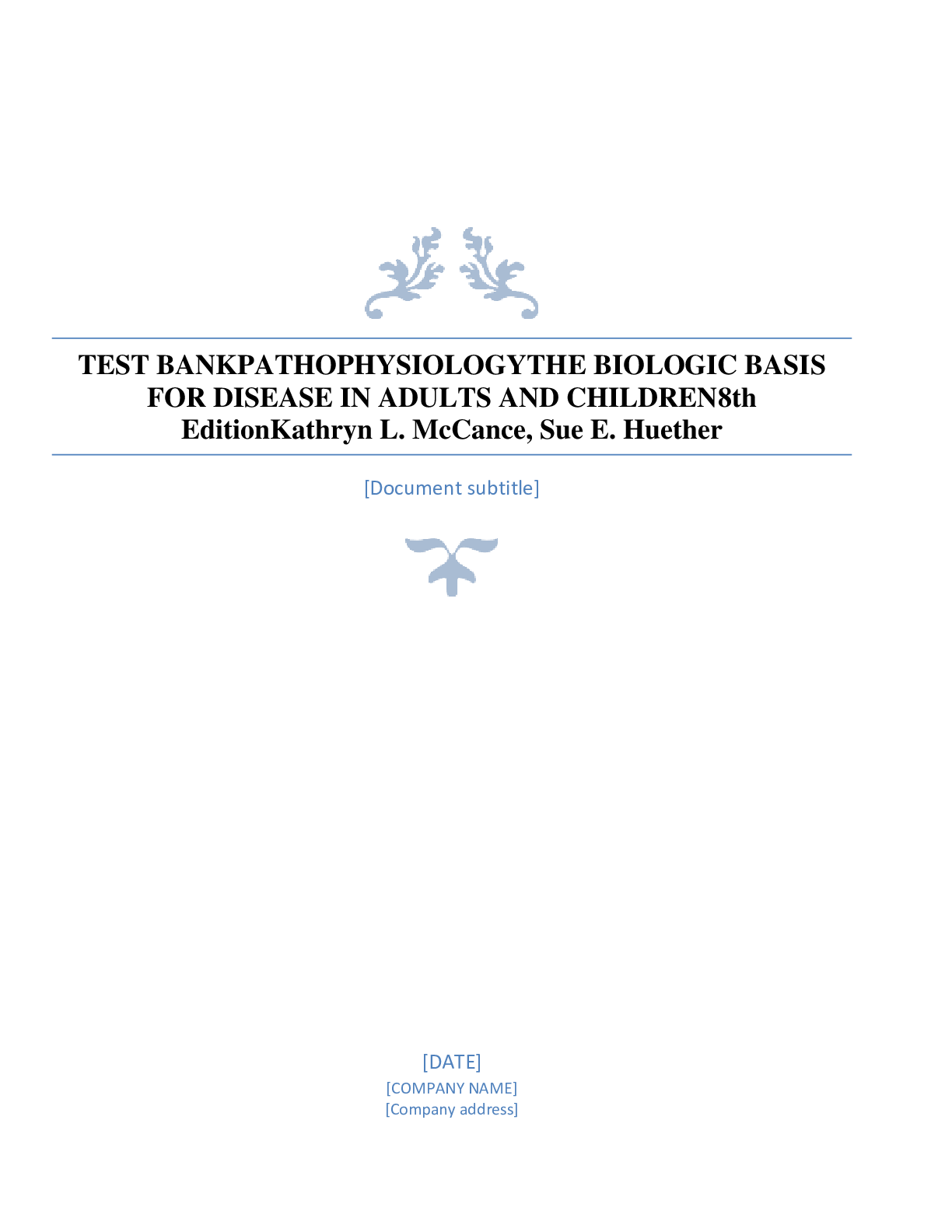

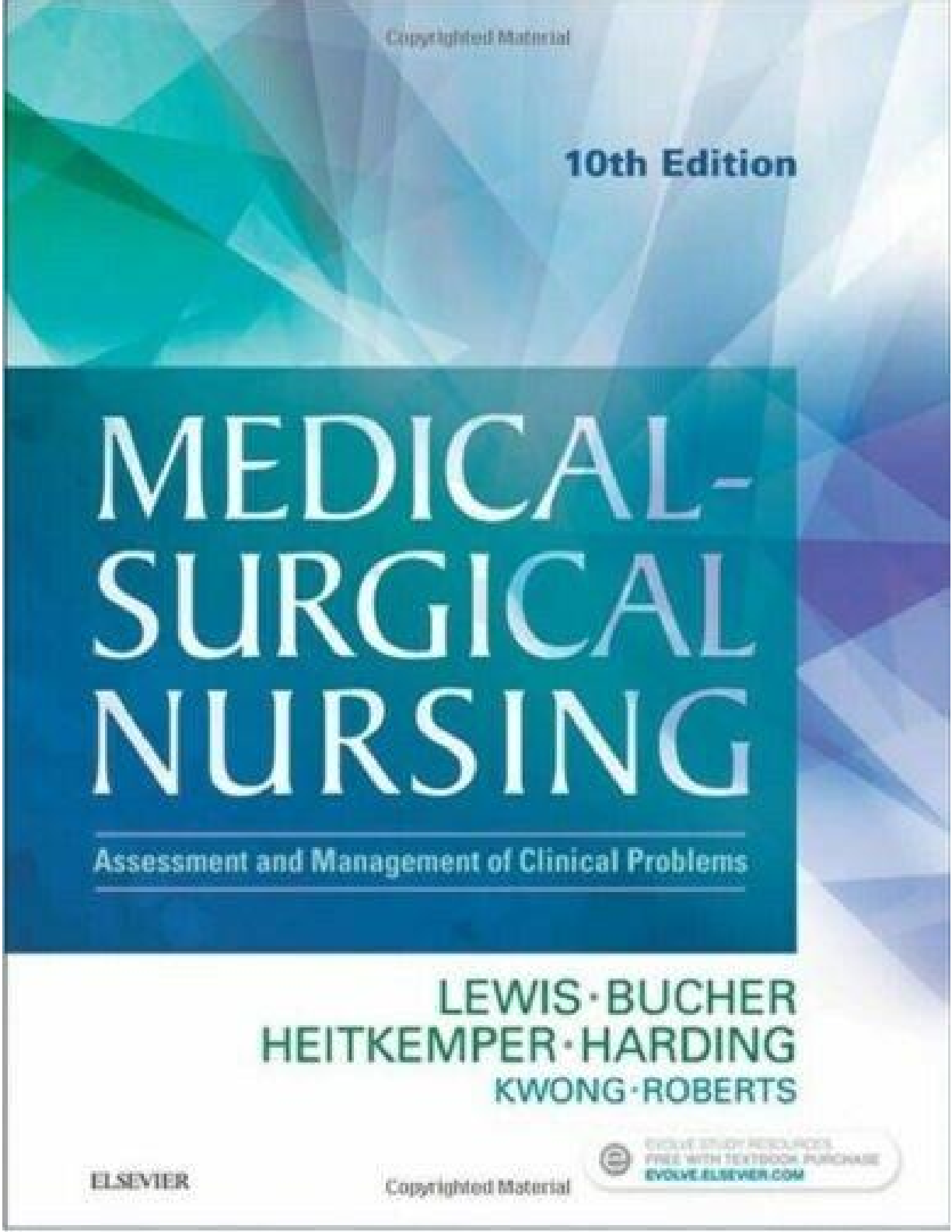
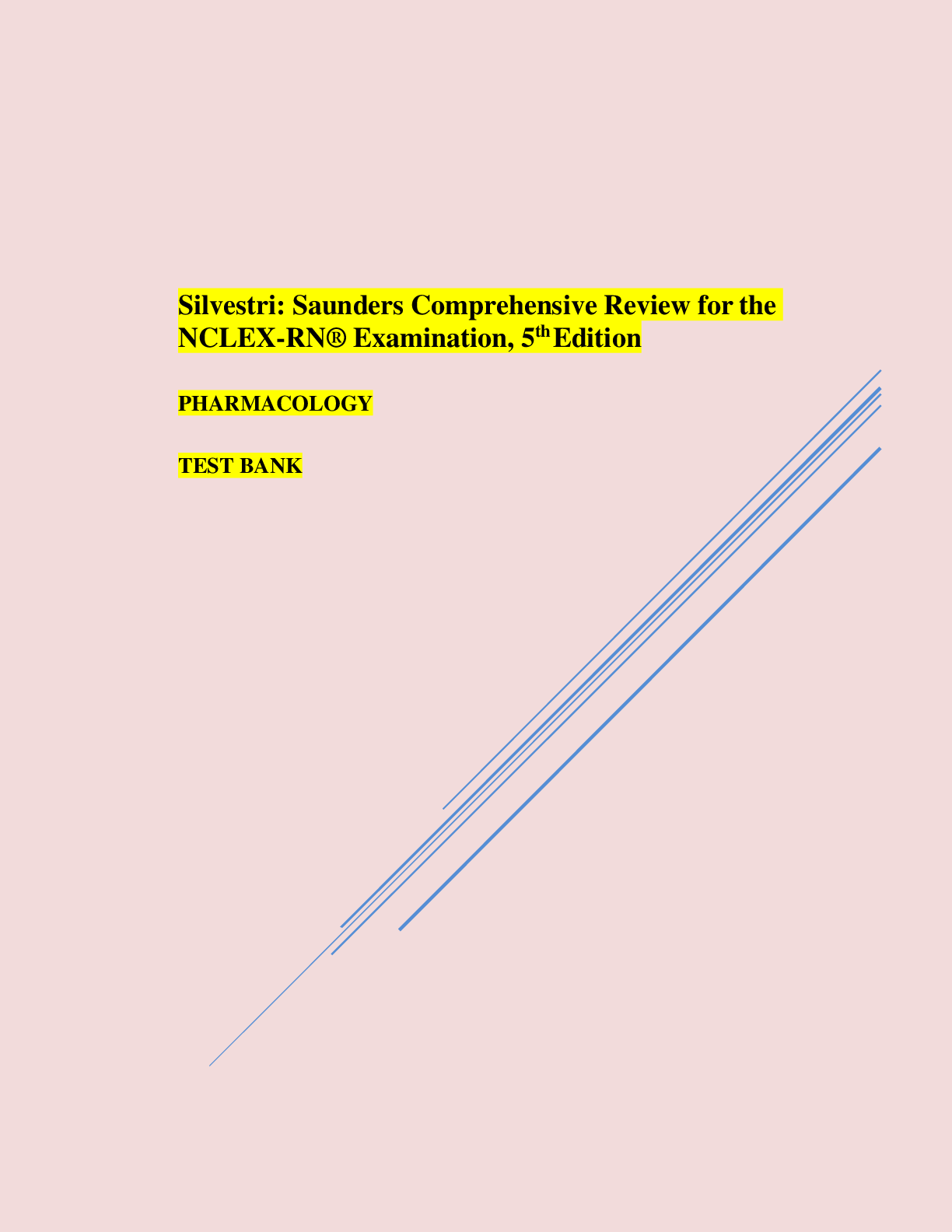


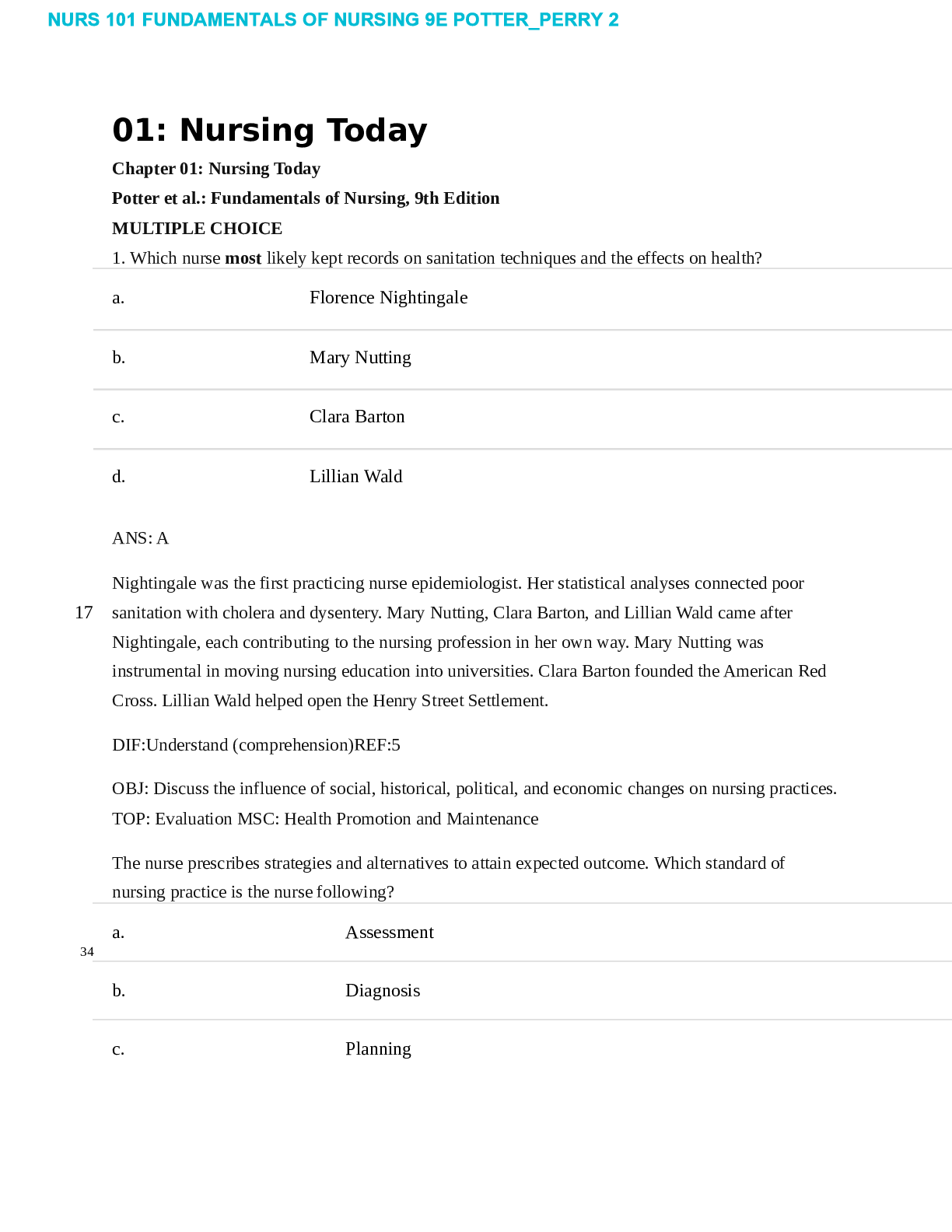

.png)
